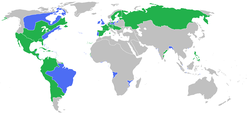French and Indian War
The French and Indian War was fought between 1754 and 1763 in British North America and French North America. They fought over land which is now in the United States and Canada. The French had some Native American allies and the British had other allies.
The conflict was a part of the Seven Years' War among the European great powers which took place in various parts of the world. France was already fighting Prussia and so did not send many troops to Canada.
Causes
- Both the British and the French thought that they owned the Ohio Country. That is land between the Appalachian Mountains and the Mississippi River, from the Great Lakes to the Ohio River. France wanted to keep New France, and Britain wanted to prevent that. Both wanted to control the fur trade and expected to send settlers someday.
- Both European countries used Native American claims to the land. The British said that it belonged to the Iroquois, and the French said it belonged to their Hurons. Neither side asked what the people of the Ohio Country might want. The land supported the beaver pelt.
- The British Thirteen Colonies feared control of the Pope in North America. France was controlled by the Roman Catholic Church. The British settlers were Protestant and saw that as a threat to their religious freedoms, which they had under English law.
Battles
The French built a new fort in the disputed territory, and the British decided to expel them. After failing in a small battle in 1754 they tried again with the Battle of Monongahela in 1755. The British commander, General Edward Braddock, died with many of his men in a failed attack against the French in what later became Pittsburgh. A militia officer, George Washington, led the defeated survivors home.[1]
At the Battle of the Plains of Abraham, the British conquered Canada.
Outcome
The fighting in North America stopped on September 8, 1760, with the French surrender of Montreal and the rest of Canada to the British.
The war ended with the signing of the Treaty of Paris on February 10, 1763. France lost all of its North American lands east of the Mississippi River to Britain except the small islands of Saint Pierre and Miquelon, near Newfoundland. Britain offered France the choice to give up its Canadian land or the Caribbean islands of Guadeloupe and Martinique, which British troops had taken during the war. France chose to keep the islands, which were valuable for their sugar plantations.
With the Royal Proclamation of 1763, colonists in British North America became unhappy over their share of the winnings. That became a cause for the American Revolution.
French And Indian War Media
Belligerents during the Seven Years' War. Canadians and Europeans view the French and Indian War as a theater of the Seven Years' War, while Americans view it a separate conflict.
The coureurs des bois were French-Canadian fur traders, who did business with natives throughout the Mississippi and St. Lawrence watershed.
Iroquois expansion, 1711. By the mid-18th century, the Iroquois Confederacy had expanded from Upstate New York to the Ohio Country.
Roland-Michel Barrin de La Galissonière, Governor of New France, sent an expedition in 1749 into the Ohio Country in an attempt to assert French sovereignty.
European colonies in North America, c. 1750. Disputes over territorial claims persisted after the end of King George's War in 1748.
Fort Le Boeuf in 1754. In the spring of 1753, the French began to build a series of forts in the Ohio Country.
In 1754, George Washington of the Virginia Regiment was dispatched to warn the French to leave Virginian territory.
References
- ↑ "The Battle of the Monongahela". World Digital Library. 1755. Retrieved 2013-08-03.
Other websites
| Wikimedia Commons has media related to Lua error in Module:Commons_link at line 62: attempt to index field 'wikibase' (a nil value).. |








